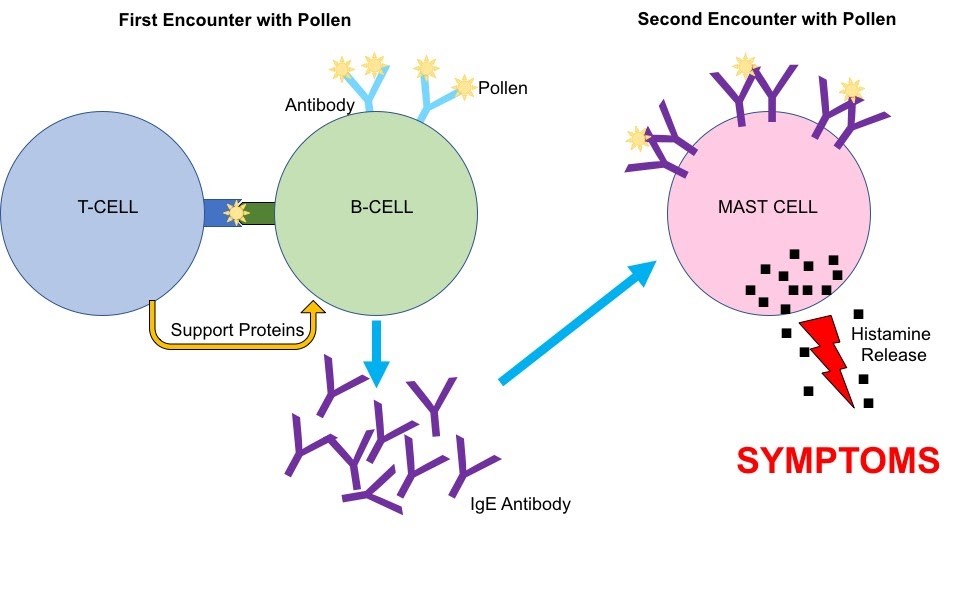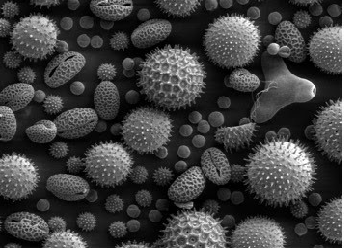By Alan Curtis
Ah, Spring- a season of renewal, growth and beautiful colors! Flowering plants and trees use pollen to reproduce. Pollen is produced by male parts of the flower and spread through the air and peaks in the spring months. For some North Carolinians, pollen makes spring a time of intense allergies. Puffy eyes, scratchy throat, hives, congestion, and shortness of breath or even asthma are all signs and symptoms of allergies. I’ve had severe allergies as long as I can remember, but I haven’t always understood what caused them. My doctor told me I was allergic to tree pollen…but what does that actually mean?
To understand allergies, we need to know a little about the immune system. Our immune system, like other human systems, is made up of a network of tissues and specialized cells. This network exists throughout the body, in the lungs, intestines, and even in the brain. The immune system helps defend against infection by surveying the body for invading microorganisms or other foreign materials and launching an attack to remove them.
B-cells are a type of immune cell that play a key role in allergies. They make antibodies, an essential part of our defense system. Antibodies are Y-shaped proteins that recognize viruses, bacteria, toxins, and even relatively large organisms like parasites in our body. In humans, there are 5 different types of antibody, each with a different role to play. Some are better at fighting bacteria (IgM type) while others are better at preventing viral infection (IgG type) or guarding our mucosal sites: eyes, mouth, intestines (IgA and IgD types).

Another immune cell, called a T-cell, helps the B-cell decide what type of antibody it will make and assists the B-cell in making the best quality antibody for the job. For example, during a viral infection (like coronavirus), T-cells would instruct B-cells to act differently than during strep throat (caused by bacteria). This process is not perfect, though.

In the case of seasonal allergies and pollen, the immune system makes a mistake. Instead of ignoring it, T-cells instruct B-cells to make the fifth type of antibody, usually reserved for parasite infection, called IgE. IgE antibodies interact strongly with a third type of immune cell, called mast cells. With every future exposure to pollen, these mast cells release histamines into the tissues in massive amounts. Histamines are small molecules used by the immune system to increase blood flow by opening up blood vessels. Depending on the intensity of the immune response and the amount of pollen present, histamines (and other chemicals) spewed by mast cells can cause everything from a runny nose to hives and even difficulty breathing!
Pollen is everywhere in North Carolina this time of year. Last year the pollen was so bad a photo taken in Durham went viral and people started referring to it as ‘The Pollening’. It is impossible to avoid it! So, how do people with allergies deal with their immune system making this mistake? There are antihistamine medicines like Claritin or Zyrtec that can help some folks temporarily. These drugs interfere with histamine receptors on cells so the tissues are essentially blind to the presence of histamine. Other people might take a prescription nose spray to keep the immune system at bay. These medicines stop the immune system from working by limiting immune activity in the nasal passages. Some patients with severe allergy will need allergy shots to help their symptoms. These injections try to correct the immune system’s mistake by training those B-cells and T-cells to change the way they react to pollen (or other substance). Allergy shots were one of the first types of approved immunotherapy and can now be taken as a pill instead.
Now I understand why I have to constantly use antihistamines, prescription nasal sprays, and tissues in the spring- it’s all because of my immune system!
Edited by Jeffrey Letourneau and Anna Wheless

